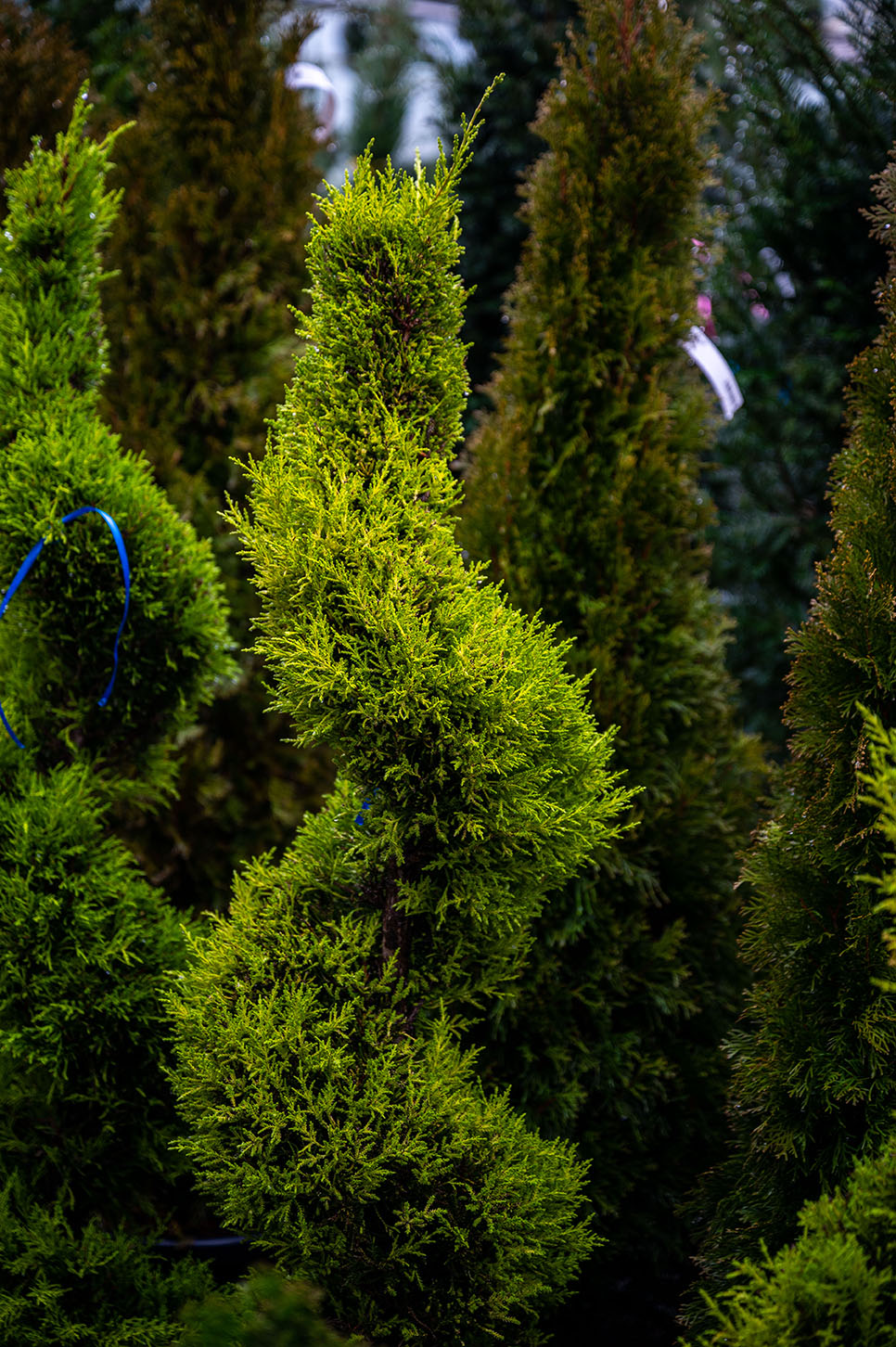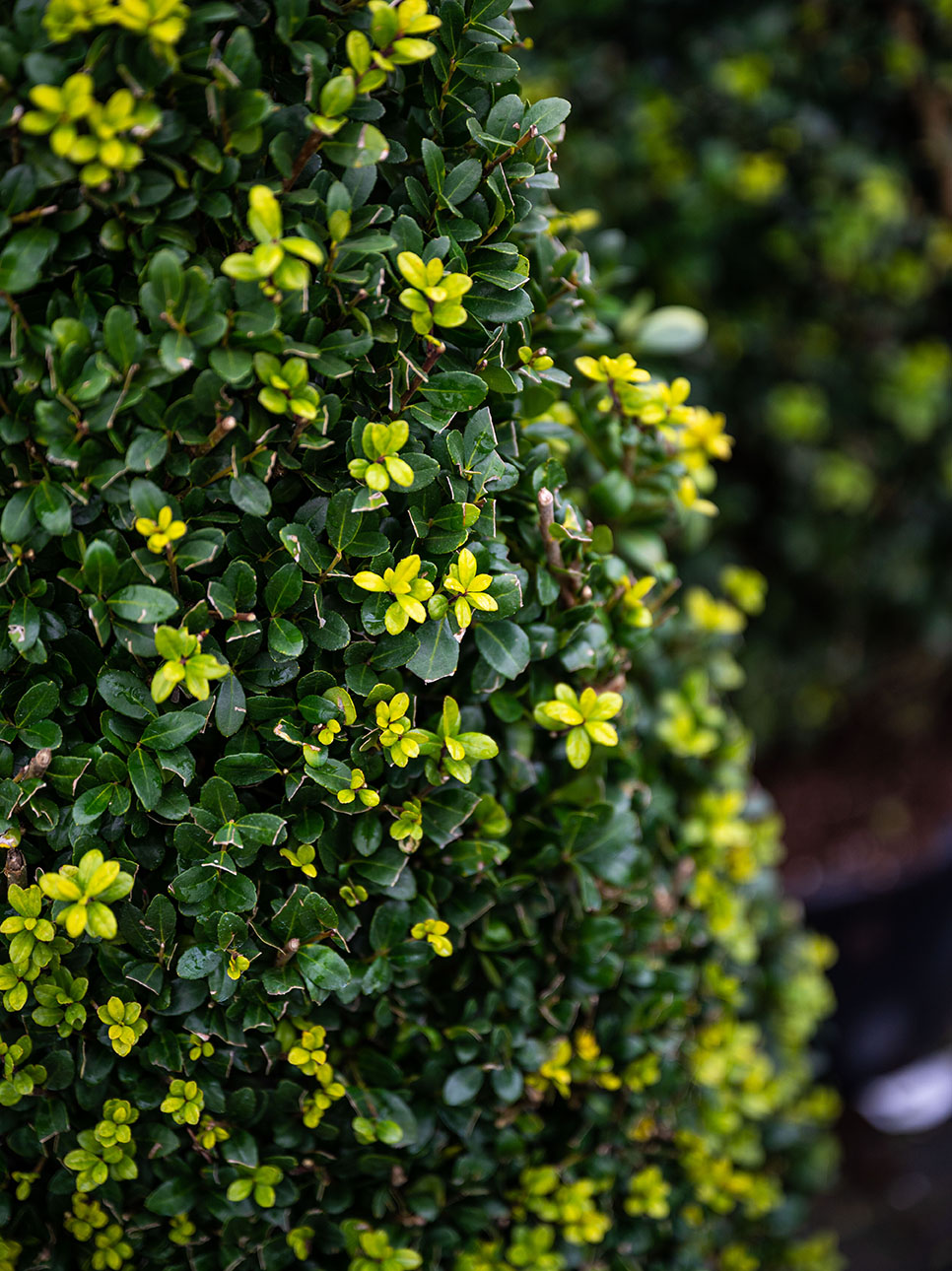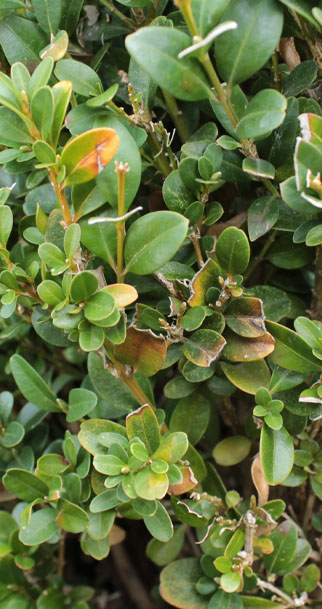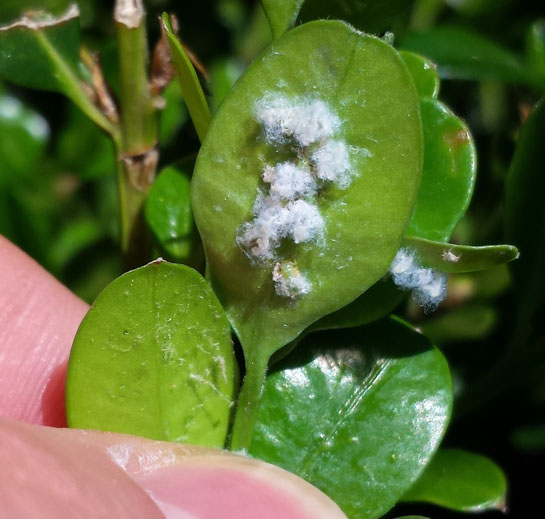Focus On: Topiary
Shaping landscapes with living architecture
Topiary is the art of trimming plants—including hedges and shrubs—into striking, elaborate forms and shapes, such as globes, cones and spirals. It has been seen historically in early Roman gardens, and continues to be a very popular styling method in today’s modern gardens.
Traditionally, evergreens have been used for topiary, in order to keep the feature for year-round interest. A large number of topiary pieces are Buxus sempervirens, commonly known as box or boxwood. However, plant health can be a concern for box, so we are continually looking for other options. Some alternative varieties for topiary include Taxus baccata (yew), Lonicera nitida (shrubby honeysuckle), Photinia x fraseri ‘Red Robin’, Cupressocyparis leylandii ‘Castlewellan’, Cupressus macrocarpa ‘Goldcrest’, Ligustrum japonicum (Japanese privet), Ilex crenata (Japanese holly) and Osmanthus x burkwoodii.
Buxus sempervirens (box)
Box is a slow-growing, evergreen shrub or small tree that usually grows up to 4-8m in height. It has beautiful glossy, dark green leaves which are around 3cm in length, and blooms clusters of yellow flowers in late spring. Once its female flowers are pollinated by wind, they transition to a green, dry capsule and will then eventually ripen and turn brown.
A dense structure and small leaves mean that box is ideal for trimming into various topiary shapes, such as spirals, cones, balls and edging for borders. As well as being easy to trim and shape, box is hardy and very tolerant to shade, drought and tough growing conditions.
Trimming box in late spring is the most ideal time of year, as it encourages side shoots to grow, which can then be cut during the summer; this will create a well-defined shape of your choice. Further side shoots will then grow, allowing for another tidy up in early autumn.
Box thrives in partial shade and well-drained soil. Be mindful of strong winds and sun as these can scorch the plant.
Unfortunately, box is susceptible to a number of box problems, such as box blight and leaf spot, and pests including box tree caterpillar and box sucker. For this reason, it’s becoming common practice to use alternatives for topiary.

Buxus sempervirens balls
Alternatives to box

Taxus Baccata 120 – 130 Cone
Taxus baccata (yew)
A bushy, medium-sized evergreen tree or shrub, yew is one of Britain’s most iconic plants for topiary and tends to grow higher than 12m. Yew can withstand hard clipping and is most suited to topiary shapes including cones and balls.
Yew leaves are dark green in colour and tend to be narrow-shaped and leathery in texture. Male and female flowers differ in colour and texture; male flowers are a whitish-yellow, and are quite globe-like. Whilst female flowers take on a more bud form, starting out green and transitioning to brown—resembling a small acorn.
Yew is generally not too fussy about its planting position or site, providing it has good drainage. Known for being a species with a particularly long life span, there are trees still standing and thriving in the UK today, which had been planted many hundreds of years ago.

Taxus Baccata Detail
Lonicera nitida (shrubby honeysuckle)
A deciduous or evergreen, dense hedge growing up to around 2m in height, Lonicera nitida, commonly known as shrubby honeysuckle, is a popular choice and well suited to a woodland garden. Shrubby honeysuckle is particularly fast-growing, making it ideal for traditional topiary, including shapes such balls and cones, as well as compact hedging.
In winter and spring, shrubby honeysuckle grows fragrant-rich flowers which tend to be creamy white in colour—but occasionally lilac, pink or yellow. After a particularly great summer, purple berries may develop during autumn.
Shrubby honeysuckle is quite easy-going and grows effectively in well-drained soil, in both partial shade and full sun. Although, it’s best to avoid wet soils and fully shaded spots. Shrubby honeysuckle is a very popular alternative to box, as it’s resistant to most diseases, such as box blight.
Photinia x fraseri ‘Red Robin’
‘Red Robin’ is a striking, medium-sized evergreen shrub, which grows to around 2.5-4m in height. With glossy, bright red foliage in summer—maturing to a darker green in autumn—it truly brings year-round interest to the garden. Its clusters of creamy white flowers in spring also add to its tremendous beauty.
A popular choice for planting in containers as a single stemmed tree, ‘Red Robin’ resembles a “lollipop” shape and is a stunning feature, making a statement outside of doorways and on patios.
‘Red Robin’ prefers fertile, well-drained, humus-rich soil and sunny or partially shaded areas. It’s generally an easy plant to care for and can be pruned any time of the year—which encourages new, vibrant, red leaves.
Cupressocyparis leylandii ‘Castlewellan Gold’
‘Castlewellan Gold’, a fast-growing, hardy, evergreen hedge, has lush sprays of yellow, golden or bronze foliage. ‘Castlewellan Gold’ is known for uncontrolled growth, however if it’s clipped in summer and autumn, its tidiness can be maintained. Some spectacular topiary shapes can be achieved with ‘Castlewellan Gold’, including spirals, columns and balls.
Generally non-fussy when it comes to positioning, ‘Castlewellan Gold’ can tolerate any normal soil, as well as full sun or partial shade. It’s ideal for acting as a windbreak and providing an element of privacy, as it can grow between 2m to 6m in height.
When it comes to pests and diseases, ‘Castlewellan Gold’ may be affected by a canker and honey fungus, as well as scale insects and conifer aphids.

Cumpressocyparis l. Castelewellan CG 150-175 Multi Pom Pom

Cumpressocyparis l. Castelewellan CG 150-175 Multi Pom Pom
Cupressus macrocarpa ‘Goldcrest’
A columnar, evergreen conifer, ‘Goldcrest’ boasts year-round interest, with scale-like, narrow, golden-yellow leaves and a pleasing scent of lemon.
It has an average to fast growth rate, with 30-60cm of growth each year, and reaching an ultimate height of at least 12m. ‘Goldcrest’ can be clipped into a variety of unique topiary styles, including pom poms and spirals.
‘Goldcrest’ is a hardy plant in most of the UK, and prefers sunny or partially shades spots, in a sheltered area with normal, well-drained soil. These growing conditions will provide the most vibrant coloured foliage.
Ilex crenata (Japanese holly)
Japanese holly is an excellent alternative to box, with its tiny, glossy leaves and dense habit. Small, white flowers bloom in summer, followed by the growth of black fruits in autumn.
This hardy plant provides year round interest and is a great selection for clipping into topiary balls. Japanese holly is fairly slow growing—10 to 20cm per year—requiring only a couple of trims per year. Japanese holly grows best in full sun or partial shade, in a moist and well-drained soil.

Ilex Crenata “Caroline Upright “ CG 110 – Cone
Ligustrum japonicum (Japanese privet)
More commonly known as Japanese privet, this hardy, evergreen shrub or small tree is an excellent, low maintenance option for topiary. Japanese privet has striking, dark green, waxy leaves and blooms creamy white flowers in mid-summer. These flowers are followed by small, round, black berries throughout autumn and winter.
Requiring only one to two trims per year, it’s very low maintenance, and generally disease and pest free. Japanese privet prefers full sun or partial shade, as well as moist, well-drained soil.
Osmanthus x burkwoodii
Osmanthus x burkwoodii is a slow-growing, large evergreen shrub, with dark green, glossy leaves. In summer, Osmanthus x burkwoodii grows clusters of stunning, highly-scented white flowers, which are then followed by black fruits in autumn.
Full sun and partial shade are preferred by Osmanthus x burkwoodii, as well as a well-drained soil. They are generally disease and pest free, making them a great, low maintenance choice for topiary.
Pruning should be carried out in April to May, and when it comes to choosing your topiary shape, domes or balls suit Osmanthus x burkwoodii very well, as it is naturally rounded in habit.
Which pests and diseases are box prone to?
Box blight
The main disease to watch out for with box is box blight. Box blight is a fungal disease, caused by the fungus Cylindrocladium buxicola, and affects the plant’s stems and leaves. Box blight results in die-back and bare patches on particular plants. The main signs to look out for are dark lesions on leaves—which will turn brown and fall—as well as young stems with black streaks. Lastly, white spores on the undersides of leaves can appear. Box blight is usually most active during wet times of the year, but it can be an all year round issue.
If you do notice signs of box blight, it’s best to act quickly and prioritise your most loved plants, as it can be very difficult to treat. It’s vital to cut out the infected parts of the plant, with clean, sharp cutting tools, as well as a good chunk of the surrounding area—this should help to stop the infection from spreading. It’s critical to carry this out in dry weather, as cutting back when it’s wet can encourage the disease to spread.
Fungicides on their own are unlikely to be effective, but they can be a good option before and after cutting back infected areas. The recommended fungicides are tebuconazole and tebuconazole with trifloxystrobin, which can be used up to six times per year. However, preventative—rather than cure—is the best strategy for managing box blight:
○ When purchasing new plants, make sure to keep them isolated for at least four weeks, to ensure they are free from infection before mixing with your healthy plants.
○ Inspect plants regularly. Know the early symptoms, as box blight can spread very quickly, especially in warm and humid climates.
○ Box blight thrives in humidity. Therefore, overhead watering isn’t recommended.

Box blight
Volutella blight
Volutella blight is a less serious disease for topiary plants. Signs of volutella blight are similar to those of box blight—however, you won’t find any black streaks. You may also spot pink spores on the undersides of leaves.
Treat volutella blight by pruning the damaged parts of the plant, making sure to clean cutting tools between each prune. Lime sulphur or copper sprays can come in handy if the infestation is severe, and it’s best to spray the plants in early spring, continuing throughout the growing season.
Regular trimming—during dry weather—helps to prevent volutella blight, by keeping plants healthy, increasing sunlight penetration and improving circulation of air. It’s also vital to water plants in the morning, giving them a chance to fully dry before the temperatures drop later on in the day. Additionally, mulching plants lightly can avoid an excessively damp environment.
Box tree caterpillar
In recent years, Cydalima perspectalis, or more commonly known as box tree caterpillar, has become a serious threat to box plants. Native to east Asia, this relatively new pest was first discovered in Britain’s private gardens in 2011.
Box tree caterpillar eats away at plant leaves, giving them a bare appearance. Small patches of dieback can also appear, causing some confusion between box blight and box tree caterpillar. Their worst damage occurs between March and October, and a box ball can be destroyed in as quickly a week.
Keep an eye out for white webbing around their feeding area, as well as droppings—otherwise known as frass. Frass is pale yellow in colour, and has a flaky consistency. You may see caterpillars among the foliage or base of the plant; however, they have a tendency to conceal themselves.
If the infestation is small, or you only have a small number of plants, you can attempt to remove the caterpillars by hand. This will need to be carried out every day to increase your chances of removing the infestation. If you see webbing, you can prune out any stems which are being covered. With larger infestations, you may need to use an insecticide, although forceful spraying is needed to get through webbing and reach the plant’s interior.

© Even Dankowicz – Box Sucker (Psylla buxi)
Box sucker
Box suckers, or psyllids, are a group of tiny insects, with over 40 different species across Britain. Box suckers are most active during April to early June. In April, young box suckers, or nymphs, feed on box plants by extracting leaf sap and secreting chemicals. This action stunts potential new growth and leads to leaf distortion. It may also be possible to spot a white, waxy secretion on or around the plant.
The damage caused by box suckers is not usually serious, and damaged shoot tips can just be removed whilst clipping. It’s good practise to check box plants regularly in April and May; this way, you can check for any signs of box suckers before they have populated to higher numbers.
Whilst there are many great benefits to box plants, it’s easy to see why individuals may be looking towards other plants for topiary. Box tolerates many difficult growing conditions and can be easily clipped into a variety of stunning topiary styles. However, box blight is a rising concern and difficult to treat once it’s established. It’s great to know you have an abundance of plant alternatives for topiary, as well as many different styles you can adopt and be creative with.
If you would like more information or have any questions on our box plant varieties and alternatives, get in touch with the G Team today!

